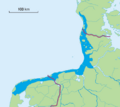Wadden Sea facts for kids
The Wadden Sea is a very special part of the North Sea. It's a huge area of mudflats and shallow waters. This means that when the tide is low, large parts of the seabed become dry land. This amazing area stretches for about 450 kilometers (280 miles) along the coast. It goes from the Netherlands all the way to the south of Denmark. The land that appears at low tide is called a mudflat. This is where the name "Wadden Sea" comes from.
Contents
What is the Wadden Sea?
The Wadden Sea is an "intertidal zone." This means it is covered by water during high tide and exposed to air during low tide. It can be up to 40 kilometers (25 miles) wide in some places. This constant change creates a unique environment.
Mudflats and Channels
When the tide goes out, you can see vast areas of mud and sand. These are the mudflats. There are also deeper channels where water always remains. These channels are like rivers flowing through the sea. The mudflats are full of tiny creatures. These creatures are food for many birds and other animals.
A Home for Wildlife
The Wadden Sea is one of the most important wetlands in the world. Millions of birds use it as a resting place. They stop here during their long journeys between the Arctic and Africa. Many animals also live here all year round.
Amazing Animals
You can find many different animals in the Wadden Sea.
- Seals: Harbor seals and grey seals live here. They often rest on sandbanks when the tide is low.
- Birds: Huge numbers of migratory birds visit. These include dunlins, oystercatchers, and barnacle geese. They feed on the worms and shellfish in the mud.
- Fish: Many types of fish live in the channels. They use the shallow waters to lay their eggs.
- Shellfish and Worms: The mud is full of clams, mussels, and different kinds of worms. These are a vital food source for other animals.
Plants of the Wadden Sea
Only special plants can grow in this salty, changing environment. Salt marshes are areas where salt-tolerant plants grow. These plants help to protect the coastline from storms. They also provide shelter for young fish and birds.
Why is the Wadden Sea Important?
This unique natural area is very important for many reasons. It is a vital ecosystem. This means it is a place where living things interact with their environment.
A World Heritage Site
Because of its special nature, the Wadden Sea is a UNESCO World Heritage Site. This means it is recognized as having outstanding universal value. It is protected so that future generations can also enjoy it. This protection helps keep the animals and plants safe.
Natural Protection
The Wadden Sea also acts as a natural barrier. It protects the coastline from strong waves and storms. The mudflats and salt marshes absorb the energy of the waves. This helps to prevent flooding in the towns and villages along the coast.
Visiting the Wadden Sea
Many people visit the Wadden Sea every year. It's a great place for nature lovers.
Fun Activities
- Mudflat Walking: You can walk across the mudflats at low tide. This is a unique experience. Always go with an experienced guide for safety.
- Bird Watching: It's a fantastic place to watch birds. Bring binoculars to see the many different species.
- Boat Trips: You can take boat trips to see seals or explore the islands.
- Beach Fun: Many islands in the Wadden Sea have beautiful beaches. You can relax, swim, or build sandcastles.
Staying Safe
The Wadden Sea can be dangerous if you don't know the tides. The water can come in very quickly. Always follow local rules and advice. If you go mudflat walking, always go with a certified guide. This will ensure you have a safe and fun experience.
Images for kids
-
People on the beach on Borkum, Germany
See also
 In Spanish: Mar de Frisia para niños
In Spanish: Mar de Frisia para niños







